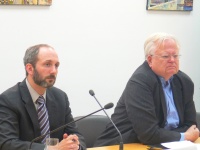Registration
You will receive an email confirming your registration.
IMGXYZ3089IMGZYXThe coalition-led war in Afghanistan began nearly ten years ago. Robert Blackwill, Henry A. Kissinger senior fellow for U.S. foreign policy at the Council on Foreign Relations, spoke at the Carnegie Moscow Center about what the United States wants for the future of Afghanistan and how this can be achieved. At the very least, he explained, both Russia and the United States desire an Afghanistan that is stable and does not export terrorism or illegal drugs. Carnegie’s Sam Greene moderated.
Current Strategy Will Fail
- New strategy needed: Blackwill said the current strategy adopted by the United States and NATO toward Afghanistan is deeply flawed and must change. Current expenditures are unsustainable; the United States suffers hundreds of troop deaths every year, and will spend a projected $120 billion on operations in Afghanistan this year alone.
- Not enough troops: Blackwill noted that the United States cannot defeat the Taliban militarily. Of the 150,000 foreign troops currently in Afghanistan, about 100,000 are American. Blackwill pointed out that in the 1980s, the Soviet Union, with 120,000 troops in Afghanistan at the height of its involvement, could not win the conflict. An estimated 300,000 to 350,000 troops would be needed to pacify the entire country, Blackwill asserted.
- Poor governance: Counterinsurgency depends on the quality of local governance, and Blackwill stated that the quality of governance under Afghanistan’s president, Hamid Karzai, is poor. The Afghan government is highly corrupt and is unable to provide services and security to its people, a situation unlikely to change.
- Afghan army not ready: The Afghan National Army will not be able to hold its own against the Taliban in a major combat role for many years—a decade at the earliest, Blackwill said. Without support from foreign troops, the Afghan military would be rapidly defeated by the Taliban, he predicted.
- Pakistan safe haven: As long as Pakistan is available to the Taliban as a safe haven and a place to train and regroup, defeating the insurgency is a next-to-impossible task, said Blackwill. The porous border between Afghanistan and Pakistan allows the Taliban to take sanctuary beyond the reach of U.S. and NATO troops.
- Americans don’t support current strategy: Blackwill noted that around 70 percent of the American public opposes the war in Afghanistan, and is unlikely to put up with a conflict for much longer.
An Alternate Strategy
Blackwill proposed his “Plan B”—an alternate strategy that will allow the United States to devote fewer resources to the conflict in Afghanistan and suffer fewer casualties.
- Leave the southeast: Blackwill said the United States should stop fighting in the Pashtun homeland in the southeastern area of the country, where most U.S. casualties occur and where the bulk of U.S. funds in Afghanistan are spent—the price of fighting in this region is too high to justify continued efforts. Instead, over the next year or so, U.S. and NATO forces in the area should withdraw. Blackwill pointed out that the Taliban would quickly take over this region and, while this is regrettable, especially after a decade-long American investment, the status quo is simply unsustainable.
- Focus on other areas: Instead, the United States should withdraw to the remainder of Afghanistan and focus on defending these areas. An American military presence should be maintained in these regions for at least the next decade, Blackwill noted. This long-term force of 30,000 to 40,000 personnel would be comprised mostly of Air Force troops and special forces, and, in cooperation with the Afghan National Army and other ethnic groups, would prevent the Taliban from conquering the rest of the country.
What Are The Other Options?
Blackwill mentioned that his strategy might be disappointing to some observers in the United States, especially those who have lost friends and relatives fighting in the Pashtun region. However the partial withdrawal strategy—while painful—is necessary, and indeed is preferable to three other options he outlined:
- Maintaining the status quo: The United States currently has around 100,000 troops in Afghanistan. According to public CIA testimony, there are only 50 to 100 al-Qaeda members in Afghanistan. This miniscule number shows that the United States has largely succeeded in its original goal of destroying al-Qaeda in Afghanistan, but along the way, ended up fighting the Afghan Taliban as well. Blackwill noted that the Afghan Taliban has currently not carried out a single terrorist operation outside of Afghanistan.
- Complete withdrawal: Another option, said Blackwill, is a total American military withdrawal from Afghanistan within the next year or two. He argued against this idea, however, saying that if the United States withdraws, then the Taliban would move north and west, and, following a brief civil war, would control all of Afghanistan. This would have serious negative consequences for the security and stability of the region.
- Negotiation with the Taliban: A third option—negotiating with the Taliban toward an outcome that protects American interests—is impossible, according to Blackwill. The Afghan Taliban’s objective is to conquer all of Afghanistan; therefore, the group would not be interested in negotiations.
